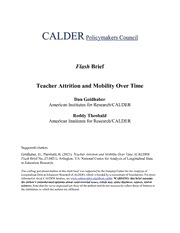
ERIC ED612299: Teacher Attrition and Mobility over Time. CALDER "Flash" Brief No. 23-0421 PDF
Preview ERIC ED612299: Teacher Attrition and Mobility over Time. CALDER "Flash" Brief No. 23-0421
CALDER Policymakers Council Flash Brief Teacher Attrition and Mobility Over Time Dan Goldhaber American Institutes for Research/CALDER Roddy Theobald American Institutes for Research/CALDER Suggested citation: Goldhaber, D., Theobald, R. (2021). Teacher Attrition and Mobility Over Time. (CALDER Flash Brief No. 23-0421). Arlington, VA: National Center for Analysis of Longitudinal Data in Education Research. The crafting and dissemination of this flash brief was supported by the National Center for the Analysis of Longitudinal Data in Education Research (CALDER), which is funded by a consortium of foundations. For more information about CALDER funders, see www.caldercenter.org/about-calder. WARNING: this brief contains the author’s unmoderated opinions about controversial issues, which may cause dizziness, nausea, and/or seizures. Note that the views expressed are those of the authors and do not necessarily reflect those of funders or the institutions to which the authors are affiliated. "Sometimes a Simple Analysis Tells the Story" Numerous stories raise concerns that as the pandemic ends, we might see a rash of public school teachers opt to leave teaching. A recent New York Times article, for instance, speculates that “The pandemic is likely to exacerbate attrition and burnout.” Amongst other evidence, it cites a RAND survey of teachers that finds that nearly half of public school teachers who left the profession in the last year cited COVID-19 as the main reason for doing so. How worried should we be that a recovering economy combined with an extremely challenging school year will lead to very high levels of teacher attrition just when school recovery efforts are kicking into high gear? Of course, it is too soon to know, but we can look at history to help gauge the magnitude of what we might expect in terms of teacher attrition. We do this using more than three decades of administrative data on the entire teaching workforce in Washington state.1 In the figure below, we plot several different measures of teacher attrition and mobility over time in Washington and see how these vary with the annual unemployment rate in the state.2 In particular, we examine data from the 1984-85 school year to the 2020-21 school year and calculate the proportion of teachers who, in the following year: 1) leave their schools and the state’s public school workforce entirely (shaded blue); 2) leave their current teaching position for a non-teaching position (e.g., administration; shaded green) within the state’s public school systems; and 3) leave their school for another public school teaching position in the state (shaded red).3 Teachers in the first two categories are called “leavers” in federal reports—though we disaggregate because rates of attrition from the workforce altogether (category 1) may be more important for policy purposes—while teachers in the third category are “movers”. Three findings jump out from this figure: 1. Not surprisingly, as employees are likely to hunker down in their current positions in uncertain times, we see that rates of teacher attrition and mobility dropped after the pandemic began. The proportion of teachers from the 2019-20 school year who left public school teaching positions (the blue and green regions in the figure) was about 8.4%, compared to rates between 9 and 10 percent in the prior five years. 2. There is a strong negative relationship between overall rates of teacher attrition and mobility (all three regions in the figure) and the state’s unemployment rate (r = -0.50); i.e., teacher attrition and mobility are counter-cyclical in that teachers are less likely to be leavers or movers when the labor market is tight. 3. There are relatively small differences in the rates of teacher attrition and mobility over time. For instance, looking from one year to the next, there is no year-to-year change in the percentage of teachers that leave public school teaching positions that is larger than 1.6 percentage points. And, looking across all 35 years of the data, the annual rates of attrition from the workforce were always in the range of 5% to 8%, while the annual rates of all attrition plus school-to-school mobility ranged from 14% to 19%.4 1 We use the public-use versions of the state’s S275 dataset, which includes annual employment information for every certificated employee of public schools in Washington State. 2 Data on annual unemployment rates in Washington were retrieved from https://fred.stlouisfed.org/series/WAUR. 3 We used the 2020-21 data to calculate attrition and mobility rates in 2019-20. 4 These rates are broadly consistent with nationally-representative estimates for selected years. 1 So, what do these historical trends suggest about the magnitude of attrition we might expect as the pandemic ends and the economy recovers? If the patterns hold, the economy roars back, and unemployment falls, we are likely to see an increase in attrition. How much is a matter of speculation; will we see the “mass exodus” that some prognosticators fear? There are of course unique elements to transition from a pandemic, but 35 years of history would suggest we are unlikely to see increases of attrition of more than a percentage point or two. Is this a concern? For sure! But it also might be an exaggeration to think of this as a mass exodus. 2 3
